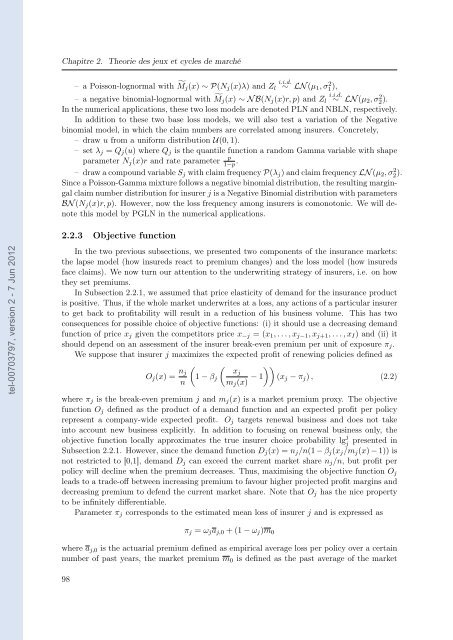Etude des marchés d'assurance non-vie à l'aide d'équilibres de ...
Etude des marchés d'assurance non-vie à l'aide d'équilibres de ...
Etude des marchés d'assurance non-vie à l'aide d'équilibres de ...
You also want an ePaper? Increase the reach of your titles
YUMPU automatically turns print PDFs into web optimized ePapers that Google loves.
tel-00703797, version 2 - 7 Jun 2012<br />
Chapitre 2. Theorie <strong><strong>de</strong>s</strong> jeux et cycles <strong>de</strong> marché<br />
– a Poisson-lognormal with Mj(x) ∼ P(Nj(x)λ) and Zl i.i.d.<br />
∼ LN (µ1, σ2 1 ),<br />
– a negative binomial-lognormal with Mj(x) ∼ N B(Nj(x)r, p) and Zl i.i.d.<br />
∼ LN (µ2, σ2 2 ).<br />
In the numerical applications, these two loss mo<strong>de</strong>ls are <strong>de</strong>noted PLN and NBLN, respectively.<br />
In addition to these two base loss mo<strong>de</strong>ls, we will also test a variation of the Negative<br />
binomial mo<strong>de</strong>l, in which the claim numbers are correlated among insurers. Concretely,<br />
– draw u from a uniform distribution U(0, 1).<br />
– set λj = Qj(u) where Qj is the quantile function a random Gamma variable with shape<br />
parameter Nj(x)r and rate parameter<br />
p<br />
1−p .<br />
– draw a compound variable Sj with claim frequency P(λj) and claim frequency LN (µ2, σ2 2 ).<br />
Since a Poisson-Gamma mixture follows a negative binomial distribution, the resulting margingal<br />
claim number distribution for insurer j is a Negative Binomial distribution with parameters<br />
BN (Nj(x)r, p). However, now the loss frequency among insurers is comonotonic. We will <strong>de</strong>note<br />
this mo<strong>de</strong>l by PGLN in the numerical applications.<br />
2.2.3 Objective function<br />
In the two previous subsections, we presented two components of the insurance markets:<br />
the lapse mo<strong>de</strong>l (how insureds react to premium changes) and the loss mo<strong>de</strong>l (how insureds<br />
face claims). We now turn our attention to the un<strong>de</strong>rwriting strategy of insurers, i.e. on how<br />
they set premiums.<br />
In Subsection 2.2.1, we assumed that price elasticity of <strong>de</strong>mand for the insurance product<br />
is positive. Thus, if the whole market un<strong>de</strong>rwrites at a loss, any actions of a particular insurer<br />
to get back to profitability will result in a reduction of his business volume. This has two<br />
consequences for possible choice of objective functions: (i) it should use a <strong>de</strong>creasing <strong>de</strong>mand<br />
function of price xj given the competitors price x−j = (x1, . . . , xj−1, xj+1, . . . , xI) and (ii) it<br />
should <strong>de</strong>pend on an assessment of the insurer break-even premium per unit of exposure πj.<br />
We suppose that insurer j maximizes the expected profit of renewing policies <strong>de</strong>fined as<br />
Oj(x) = nj<br />
<br />
xj<br />
1 − βj − 1 (xj − πj) , (2.2)<br />
n mj(x)<br />
where πj is the break-even premium j and mj(x) is a market premium proxy. The objective<br />
function Oj <strong>de</strong>fined as the product of a <strong>de</strong>mand function and an expected profit per policy<br />
represent a company-wi<strong>de</strong> expected profit. Oj targets renewal business and does not take<br />
into account new business explicitly. In addition to focusing on renewal business only, the<br />
objective function locally approximates the true insurer choice probability lg j<br />
j<br />
presented in<br />
Subsection 2.2.1. However, since the <strong>de</strong>mand function Dj(x) = nj/n(1 − βj(xj/mj(x) − 1)) is<br />
not restricted to [0,1], <strong>de</strong>mand Dj can exceed the current market share nj/n, but profit per<br />
policy will <strong>de</strong>cline when the premium <strong>de</strong>creases. Thus, maximising the objective function Oj<br />
leads to a tra<strong>de</strong>-off between increasing premium to favour higher projected profit margins and<br />
<strong>de</strong>creasing premium to <strong>de</strong>fend the current market share. Note that Oj has the nice property<br />
to be infinitely differentiable.<br />
Parameter πj corresponds to the estimated mean loss of insurer j and is expressed as<br />
πj = ωjaj,0 + (1 − ωj)m0<br />
where aj,0 is the actuarial premium <strong>de</strong>fined as empirical average loss per policy over a certain<br />
number of past years, the market premium m0 is <strong>de</strong>fined as the past average of the market<br />
98
















